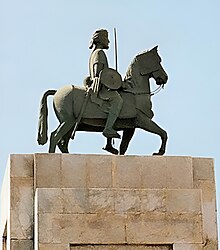This is an old revision of this page, as edited by Weliviewf (talk | contribs) at 05:53, 9 December 2024 (Removed peacock/promotional wording.). The present address (URL) is a permanent link to this revision, which may differ significantly from the current revision.
Revision as of 05:53, 9 December 2024 by Weliviewf (talk | contribs) (Removed peacock/promotional wording.)(diff) ← Previous revision | Latest revision (diff) | Newer revision → (diff) Somali clan familyThis article has multiple issues. Please help improve it or discuss these issues on the talk page. (Learn how and when to remove these messages)
|
| بنو مرسل Murusade | |
|---|---|
| Hawiye Somali clan | |
 | |
| Ethnicity | |
| Nisba | Adari |
| Location | |
| Descended From | Sheikh Ahmed Bin Abdulrahman Bin Uthman |
| Parent tribe | Karanle |
| Branches | Sabti:
|
| Language | |
| Religion | Sunni Islam |
 |
| Part of a series on |
| Somali clans |
|---|
| Darod |
| Isaaq |
| Dir |
| Hawiye |
| Rahanweyn |
The Murusade, (Somali: Murursade, Mursal; Arabic: مرسذه ,مرسل) also contemporarily known as Mursal, are a Somali sub-clan, part of the Karanle branch of the larger Hawiye clan. They primarily reside in the central regions of Somalia, particularly in the Galgaduud, Lower Shabelle, Middle Shabelle and Banaadir regions.
The Mursal traditionally consist of nomadic pastoralists, coastal people, merchants and farmers. They are also one of the earliest inhabitants of Mogadishu, the capital city of Somalia.
Origins and Etymology

The Murusade are a prominent sub-clan among the larger Karanle Hawiye clan family. Hawiye trace their lineage back to Irir, one of the sons of Samaale. Consequently, the Murusade share close kinship ties with other Samaale clans.
The Murusade are part of the Karanle clan family, which consists of various sub-clans, including the Gidir, Kariye, Sixawle and the Murusade themselves. Murusade, youngest son of Karan, shares the same mother as Sixawle and their sister Faduma. Gidir and Kaariye were born from another mother.
The Karanle clan, to which the Murusade belongs, was historically involved in combating foreign invaders in the Greater Somalia region as these two nations historically shared an extensive border.
{{Blockquote|text="Gum, myrrh, ostrich feathers, ivory, incense abound in Karanle; they don't grow the coffee they get from the Galla. They have camels, cattle, sheep and horses in fair quantities....They alone, led by Omar-Abdi, had the courage to face the 15 thousand Amhara raiders in the Ogaden."}
- "Galgaduud | European Union Agency for Asylum". euaa.europa.eu. Retrieved 2024-08-17.
- ^ "EASO Country of Origin Information report. South and Central Somalia Country overview". Refworld. pp. 52–53. Retrieved 2024-08-17.
- International organisation for immigration in Somali: Community Stabilization Index Lower Shabelle – January 2022 https://somalia.iom.int/sites/g/files/tmzbdl1041/files/documents/COSI_Lower%20Shabelle_Location_Report_Afgooye.pdf Archived 2023-03-23 at the Wayback Machine
- https://coi.euaa.europa.eu/administration/easo/PLib/2021_09_EASO_COI_Report_Somalia_Security_situation.pdf p:103
- "Maggiore, Corpo Di Stato". Tipografia Regionale. 1938. p. 40. Archived from the original on 2023-04-14. Retrieved 2023-04-14.
- Abbink, Gerrit Jan; Bruijn, Mirjam De; Walraven, Klaas Van (2003). Rethinking Resistance: Revolt and Violence in African History. BRILL. ISBN 978-90-04-12624-4.
- Ahmed, Ali Jimale (1995). The Invention of Somalia. The Red Sea Press. ISBN 978-0-932415-99-8. Archived from the original on 2024-05-22. Retrieved 2024-04-04.
- "(PDF) Karanle Hawiye Irir Samaale Hiil Abroone Sixawleftpmirror.your.org/pub/wikimedia/images/wikipedia/so/b/b...Taacuud Faasi Axmed Makki Garaad Kaamil Aw Qariib Afxaaj Laagsuge Buraale". dokumen.tips (in Somali). Archived from the original on 2024-03-03. Retrieved 2024-03-03.
- Jama, Hassan Ali (2005). Who Cares about Somalia: Hassan's Ordeal ; Reflections on a Nation's Future. Verlag Hans Schiler. ISBN 978-3-89930-075-8.
- Abbink, J. (1999). The Total Somali Clan Genealogy: A Preliminary Sketch. African Studies Centre.
- ^ Atti (in Italian). 1894. p. 362.